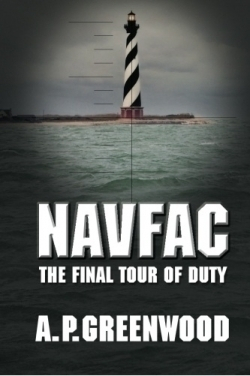NAVFAC
The Final Tour of Duty
NAVFAC: The Final Tour of Duty is a Tom Clancy-style flashback to the Cold War of the 1970s, when the United States tracked the Russians, the Russians tracked the United States, and nuclear submarines prowled the seas, ready for combat. Set against the backdrop of North Carolina’s Outer Banks, the novel follows the final year in Navy Lieutenant Commander Alex Wolfe’s career. It is a year Wolfe hopes to ride out in the relative safety of the bunker-like building where the Naval Facilities Engineering Command, known as NAVFAC, tracks US and Russian submarines and ships in the Atlantic. But Wolfe’s assignment to the position of base legal officer—a job he has no qualifications for—will bring him unexpected problems in the form of a series of grisly murders of young navy men that the local sheriff lacks both the expertise and the willingness to solve.
From the opening scene, when a US submarine is sent on a secret mission far different from the usual “war games,” author A.P. Greenwood, a former naval officer, draws his readers into a story that bounces between the secret machinations under the Atlantic and the bunker near Cape Hatteras, where skilled operators can “read” the distinctive signatures of ships and subs and track their maneuvers. Outside the bunker, there are different machinations afoot. Wolfe is trying to shift his life toward a more civilian notion of “normal” with the assistance of an attractive local fishing guide who teaches him surf casting. His commander is a blustering, incompetent bully with a seductive wife. Meanwhile, a subordinate detects something suspicious suggesting an undersea explosion on the sonograms involving American and Russian subs—something higher-ups do not want revealed—and the conflict between locals and navy personnel is heating up in the form of two more murdered sailors.
The book suffers from minor typos that detract from the rapid pace. For example, on page twenty-three we find: “… and then she I began a conversation.” And, on page 110: “Kenny s said, ‘Let’s get out of here.’” Despite these issues, and the darkness of the plot, Greenwood has a breezy style that makes the book a fast read. Although the renegade who bucks authority is a familiar character in military fiction, Alex Wolfe is an engaging hero.
Wolfe’s honesty with his men feels genuine. His struggles to master surf casting so he can impress “the girl” are amusing. Best of all, in Wolfe, Greenwood gives us a man who won’t settle for the easy answer and keeps an open mind about how three murders, apparently done by the same person or persons, may actually point in two very different directions—one of which has significant national implications. Readers may find themselves wishing Wolfe had learned from his past mistakes—a more adept style of handling conflict, the good sense to avoid the temptations of his boss’s wife, and fewer reminders to himself that he wants to get through the year without screwing up. Ultimately, a moral hero takes an immoral deal.
Reviewed by
Kate Flora
Disclosure: This article is not an endorsement, but a review. The publisher of this book provided free copies of the book and paid a small fee to have their book reviewed by a professional reviewer. Foreword Reviews and Clarion Reviews make no guarantee that the publisher will receive a positive review. Foreword Magazine, Inc. is disclosing this in accordance with the Federal Trade Commission’s 16 CFR, Part 255.

